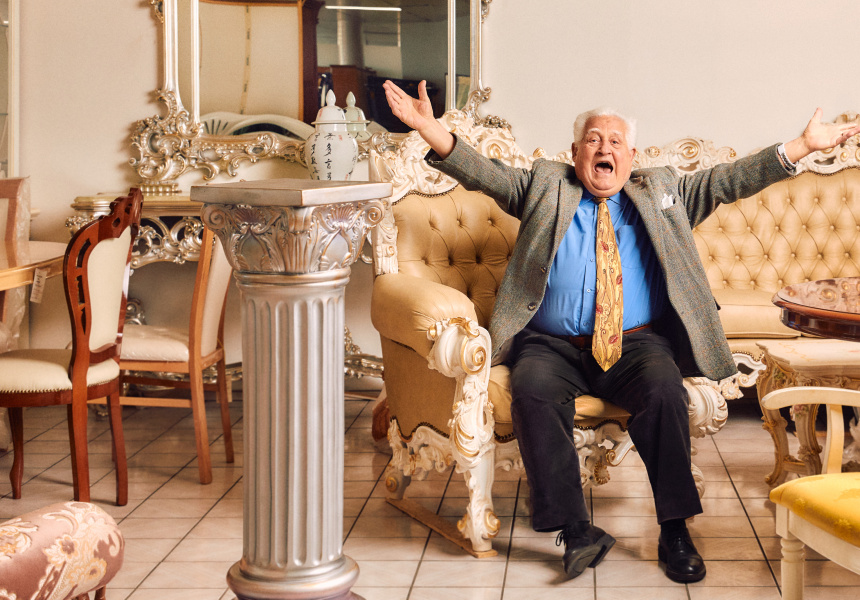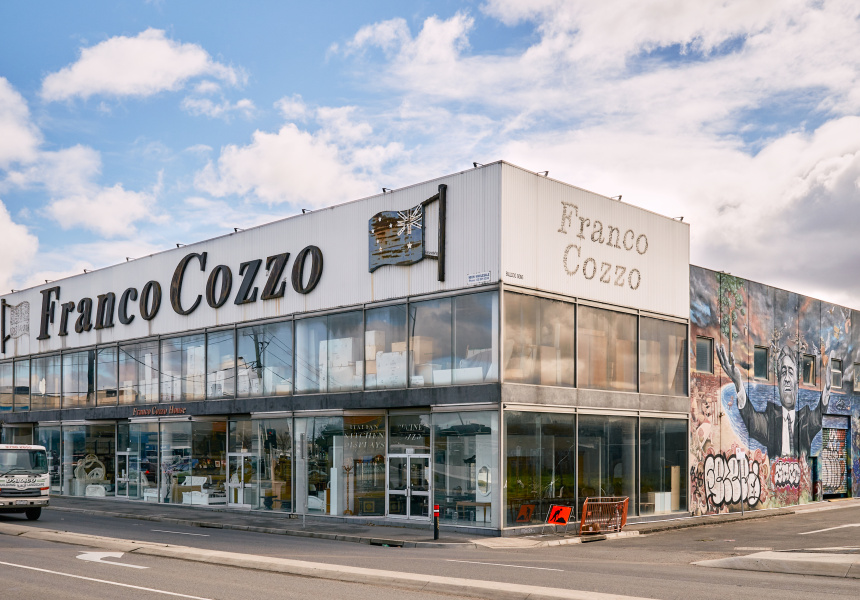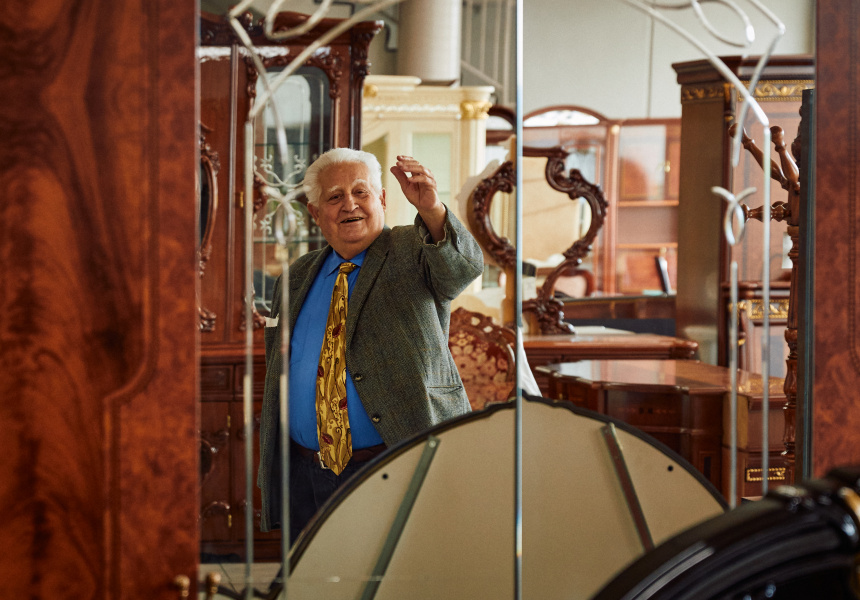This article was originally published on August 9, 2021. News of Franco Cozzo’s passing was shared on his Instagram and Facebook on December 20, 2023.
“Megalo, megalo, megalo!”
It’s the slogan Italian-Australian Franco Cozzo used to spruik his Baroque-style furniture in low-budget ’80s TV ads. But “megalo”, meaning “large” in Greek, is just as true of the 85-year-old’s charismatic personality. The furniture mogul, who came from Sicily to “Foot-is-cray” in 1956, commands the (show)room with his tongue-in-cheek humour, unmistakable thick accent and heady splash of cologne.
We think you might like Access. For $12 a month, join our membership program to stay in the know.
SIGN UPWhen I arrive at the Footscray showroom pre-lockdown, Cozzo’s chatting to another journalist in the mezzanine-level office. He’s been in back-to-back interviews ahead of the world premiere of Palazzo di Cozzo, a documentary by local filmmaker Madeleine Martiniello. The 86-minute film is a touching tale of Cozzo’s work and personal life, simultaneously telling of how immigrant groups made their mark across Melbourne during that time. (“Franco, you’re a movie star!” I say later, in jest. He replies: “How many times I gotta tell you? I am a movie star – with no money.”)
Ahead of our sit-down, his wife Assunta pops into the office to let him know I’ve arrived. Through the window, I watch him tidy his desk, straighten his chair – as well as his tie – and head down the stairs. (But not before spritzing on his signature scent and catching his reflection in the mirror of a dressing table crammed tightly into his office.) When the door swings open, the new furniture smell is surpassed seamlessly by eau de Cozzo.
During the pre-interview photoshoot, Cozzo parades proudly around the showroom. He entertains us with a drum solo on a decorative Roman-style plinth, a dashing rendition of Il Divo’s Grazie Amore Mio, a demonstration of how he’d kick a goal for the Doggies, and a raft of cheeky comments. “Abbiamo finito? (Are we done?)” he asks, followed closely by, “Damma mangiare, che c’ho fame (Let me eat, I’m hungry).”
Over six decades, Cozzo has built an empire – and by now he has a legion of loyal customers and even more loyal fans. There’s a laneway unofficially named after him and a giant mural in his honour. And the selfie requests come in a steady stream. “When the public sees me, shakes my hands or kisses me … I feel very proud,” he tells me. “All of Melbourne is my friend.” “They love you,” I encourage. “Bravo. I love [those] who love me … If you respect me, I will respect you triple.” But despite becoming a household name, Cozzo’s humility is unwavering. “I’m the same man [as the one who] arrived in Australia … I got where I live, I got plenty mangiare [to eat], I’ve got everything I want.”
As for business? It’s quieter now. Cozzo was part of the 1950s post-war wave of mostly Mediterranean migrants, as were his early customers. But now the demographic after his ornate, ostentatious furniture is more varied. Cozzo also says people’s tastes have changed since he first opened in 1960. “Ma intanto cosa possiamo fare? … Si tira avanti (But in the meantime, what can we do? … It goes on),” he says. “If you’re not happy, you’ll be sick.”
Dipping in and out of Italian and English, the Melbourne icon takes every opportunity to share words of wisdom with me. I do my best to keep up and take them all in. (Afterwards, I even ask my Italian-speaking mum to sit down with me and listen over the interview recording in case I missed anything.)
“L’educatione è la cosa più bella del mondo (Education is the most beautiful thing in the world),” he says. I understand him but – ironically – it’s at this moment I wish I’d followed through with my plan to take Italian lessons so I could respond eloquently.
Instead, I smile and reply in English, the same way I have with my grandparents for years. Cozzo’s passion for education is reflected in his intentions for his grandchildren. When I visit, his grandson (with whom he shares a full name) is helping in the showroom. I ask the elder Cozzo whether he plans to hand the baton onto the younger Cozzo in the future, but he says school is more important than business. “Se non sai leggere non può fare niente (If you can’t read, you can’t do anything).” It’s not a no.
Cozzo’s trilingual advertising (Italian, Greek and English) was an important normaliser for multiculturalism in Melbourne. “[It] really drives people crazy but sticks in your head,” filmmaker Martiniello told Broadsheet in 2018. “It’s just a TV ad but it has a place in the public consciousness.” And she’s right; it’s become engrained in Melbourne’s pop-culture fabric.
“The commercial is the life of the business,” he says. But why was the Sicilian-born Cozzo hell-bent on adding Greek to his vernacular? It’s simple, really. Greek-Australians were also prominent in Footscray and Brunswick (where he also has a store) in the ’80s. “To get them you’ve got to give them something, and [so] I learnt a few words,” he says. “Megalo, megalo, megalo. Xepulima sto (clearance sale at) Franco Cozzo.” The words roll off his tongue as if he were a native speaker.
The production of this film has forced Cozzo to reflect on his 65 years in Australia. “È cambiata la vita (life has changed) … I’m getting [older] … I’ve got everything, but I don’t have the age. Nobody can buy the age. I’m older but I’m very happy,” he says.
As the interview is wrapping up I remember to peek over at the dressing table. Bottles of Davidoff Champion and Dior Farenheit take pride of place. Of course. At heart, he’s still that youthful 21-year-old Sicilian guy who arrived in 1956 – just now with the addition of 10 kids, two houses, a couple of thousand Instagram followers and a film in his honour.
Palazzo di Cozzo is streaming now.



